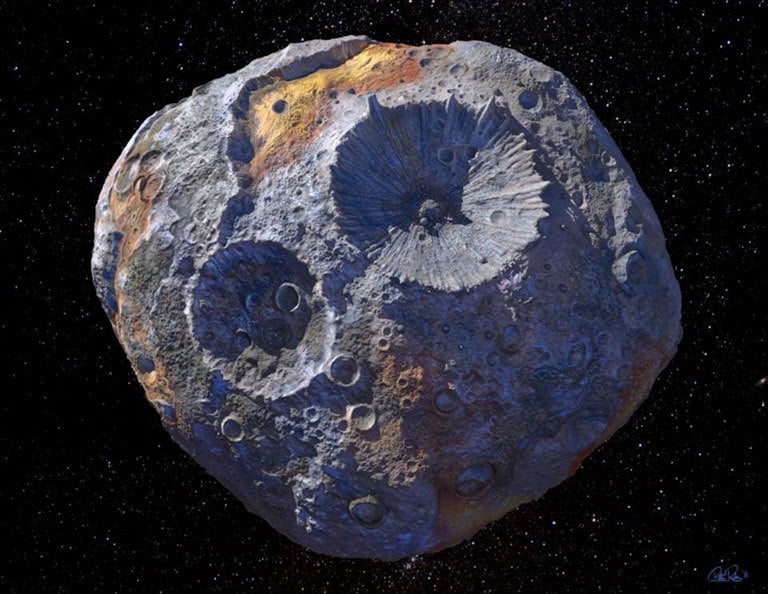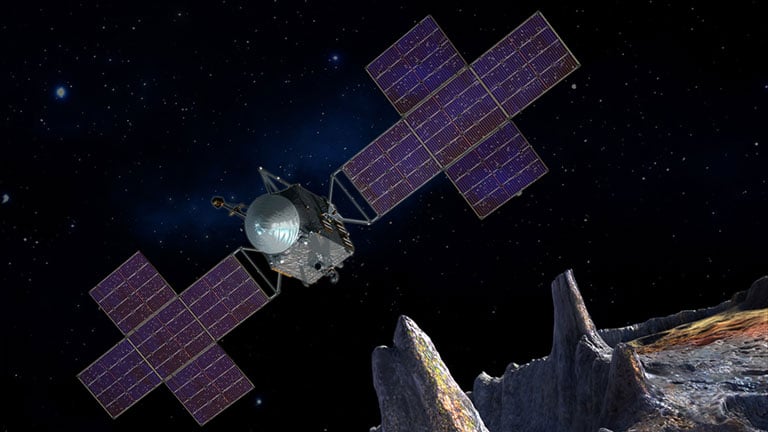
NASA is on a mission to explore a Greek-named asteroid called 16 Psyche that contains a double-edged sword. Made completely of metal, it boasts enough gold to either make every person on Earth a billionaire—or to collapse the gold market and destabilize the entire global financial world.
The Psyche mission — named after the asteroid it’s planning to study — is set to blast off on Thursday atop a SpaceX Falcon Heavy rocket from Cape Canaveral, Fla., where it will begin a six-year journey to its home in the asteroid belt.
Once it arrives, it will continue to orbit Psyche for two years, where it will study things such as its composition, age and topography.
The heavenly body Psyche, which was discovered by Italian astronomer Annibale de Gasparis on March 17, 1852, was named after the Greek goddess of the soul who was born a mortal but married Eros, the god of love.
Located between the orbits of the planets Mars and Jupiter, Psyche is no average asteroid. Asteroids are most often made of rock and/or ice for the most part, but Psyche is comprised of solid metal.
Psyche’s power is a double-edged sword
Much like all other figures of Greek mythology, Psyche is powerful—and may cause trouble for humanity if and when she is mined for the precious gold she is made of because the wealth she represents could send Earthly financial markets into a tizzy.
Psyche also contains large amounts of platinum, iron, and nickel, making her worth even more astronomical.
Experts have estimated that the various metals the asteroid is made of are worth an eye-popping $10,000 quadrillion.

And this may be too much of a good thing—as so often happens with the Greek gods as they are portrayed in Greek mythology.
If all Psyche’s riches were somehow transported back to Earth, their worth would destroy commodity prices and therefore cause the world’s economy—worth at least $75.5 trillion—to collapse as a result.
NASA describes 16 Psyche as a giant metal asteroid about three times farther away from the sun than is the Earth. Its average diameter is about 140 miles (226 kilometers)—about one-sixteenth the diameter of Earth’s moon or about the distance between Los Angeles and San Diego in the US.
Psyche takes about five Earth years to complete one orbit of the sun, but only a bit over four hours to rotate once on its axis (a Psyche “day”).
Asteroid could be the remains of a planet after a gigantic collision
Unlike most other asteroids that are rocky or icy bodies, scientists think the M-type (metallic) asteroid is comprised mostly of metallic iron and nickel—very similar to Earth’s core.
Scientists speculate whether Psyche could actually be an exposed core of an early planet that lost its rocky outer layers due to a number of violent collisions billions of years ago.
Astronomers on Earth have studied 16 Psyche in visible and infrared wavelengths, as well as radar, which suggests she is shaped “somewhat like a potato,” according to NASA.
Psyche 16’s existence has been known for some time, but recent advancements in interplanetary research, including several successful Mars landings, have made researchers refocus on mining potential for such asteroids.
Scott Moore, the head of EuroSun Mining, told interviewers from the energy publication Oil Price that the almost unfathomable amounts of gold in the asteroid threaten to completely upend the gold industry on Earth.
“The ‘Titans of Gold’ (gold mining operators) now control hundreds of the best-producing properties around the world,” he explained to interviewers from the website.
“But the 4-5 million ounces of gold they bring to the market every year pales in comparison to the conquests available in space,” added Moore.
“Discovery Mission” headed to asteroid in 2022
In an update from NASA posted online, they said a team of 30 engineers and technicians are working around the clock to get the spacecraft, also called Psyche, ready. When Psyche is unfurled in flight it will be about the size of a singles tennis court and it is scheduled to arrive at the metal-rich asteroid in 2029.
NASA’s Jet Propulsion Lab confirmed that it has recently completed a comprehensive test of the flight software, successfully installing it on the spacecraft and it has been cleared the way for the upcoming launch at 10:38 a.m. EDT (14:38 GMT) on Thursday, October 5, 2023.
A SpaceX Falcon Heavy is targeted to launch Psyche from Launch Complex 39A at Kennedy Space Centre.
That gives us Earthlings just enough time to contemplate exactly what might happen if and when Psyche’s riches are somehow exploited and brought back to our own planet.
NASA officials say that the Psyche 16 expedition was planned as part of a purely scientific effort. They stress that no mining will take place as part of their missions.
Incredibly, the ownership, and mining, of asteroids is completely legal, according to agreements signed in 2015. A raft of companies are already planning to cash in on the new source of precious minerals on these heavenly bodies—not just the glittering gold and platinum but also the vital commodity of iron, used in the manufacture of steel.
Mission may provide insight into planetary formation
NASA states that Psyche 16 was most likely formed after the powerful collisions of planets which occurred routinely as our solar system was in the process of formation.
This information alone is invaluable, never mind what her minerals are worth, since “her composition could tell us how Earth’s core and the cores of the other terrestrial planets in the solar system were first formed, according to NASA scientists.
Two space mining companies—backed by major investors—geared up for a modern-day gold rush after asteroid ownership was made legal in 2015.
Deep Space Industries, which was later acquired by Bradford Space Group, was initially oriented around the exploitation of asteroid-based minerals. Later shifting its focus to satellite propulsion, it has now backed away from the controversial concept of harvesting precious minerals from space.
Mining companies back out of controversial—perhaps impractical— venture
It was initially joined by the firm Planetary Resources in the quest of asteroid mining, but it too dropped out of the running, and the company was absorbed by a blockchain company in late 2019.
The two space development companies had originally set their sights on a second asteroid, called “2011 UW158,” which is twice as large as the Tower of London and whose worth was estimated to be up to $5.7 trillion at the time.
Billionaires had at one time lined up to invest in Planetary Resources, which is now part of ConsenSys and describes itself as a “blockchain venture production studio focused on building and scaling tools, disruptive startups, and enterprise software products powered by decentralized technology, specifically Ethereum,” according to Space News.
Ethereum is a decentralized monetary platform that is best known for its cryptocurrency called Ether; it is similar to Bitcoin.
Thus, it appears the speculative interest in asteroid mining has abated somewhat at the present time. For now, it seems the only activity the Greek-named asteroid needs to worry about is the NASA scientific and exploratory mission.
“After over 21 months in orbit,” NASA officials state, “the spacecraft will map and study 16 Psyche’s properties using a multispectral imager, a gamma-ray and neutron spectrometer, a magnetometer, and a radio instrument (for gravity measurement). The mission’s goal is, among other things, to determine whether Psyche is indeed the core of a planet-sized object.”
The mission will be the very first such effort to investigate a world that is made of metal rather than primarily rock and ice.
Deep within rocky, terrestrial planets, including our Earth, scientists infer the presence of metallic cores, but these lie at unreachable depths below their rock mantles and crusts.
Because scientists still cannot see or measure Earth’s core directly, the Psyche mission offers a unique window into the violent history of collisions and accretion that created terrestrial planets in our solar system.
You can keep up with the developments regarding the 16 Psyche mission by reading NASA’s blog on the effort, here.
See all the latest news from Greece and the world at Greekreporter.com. Contact our newsroom to report an update or send your story, photos and videos. Follow GR on Google News and subscribe here to our daily email!



